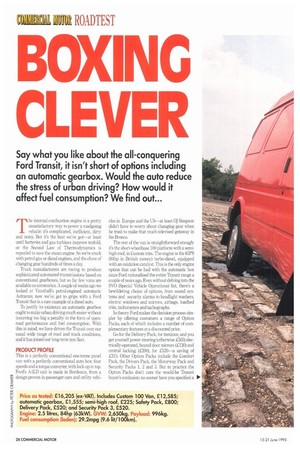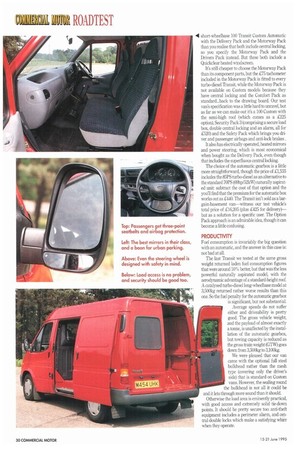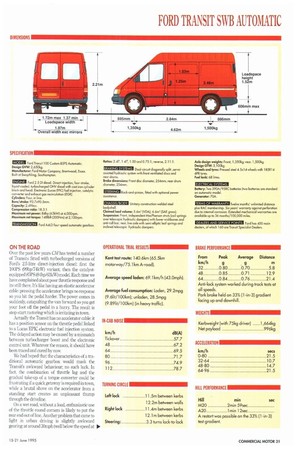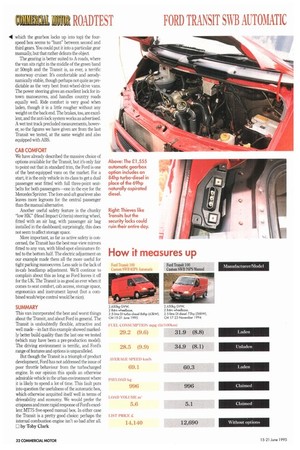BO X I NG CLE VE R T he internal-combustion engine is a pretty unsatisfactory way
Page 30

Page 32

Page 33

Page 34

If you've noticed an error in this article please click here to report it so we can fix it.
to power a roadgoing vehicle: it's complicated, inefficient, dirty and noisy. But it's the best we've got—at least until batteries and gas turbines improve tenfold, or the Second Law of Thermodynamics is repealed to save the steam engine. So we're stuck with petrol gas or diesel engines, and the chore of changing gear hundreds of times a day
Truck manufacturers are racing to produce sophisticated automated transmissions based on conventional gearboxes, but so far few vans are available as automatics. A couple of weeks ago we looked at Vauxhall's petrol-engined automatic Astravan; now we've got to grips with a Ford Transit that is a rare example of a diesel auto.
To justify its existence an automatic gearbox ought to make urban driving much easier without incurring too big a penalty in the form of openroad performance and fuel consumption. With this in mind, we have driven the Transit over our usual wide range of road and track conditions, and it has joined our long-term test fleet.
PRODUCT PROFILE
This is a perfectly conventional one-tonne panel van with a perfectly conventional auto box: four speeds and a torque converter, with lock-up in top, Ford's A4LD unit is made in Bordeaux, from a al design proven in passenger cars and utility vehi cks in Europe and the US—at least OJ Simpson didn't have to worry about changing gear when he tried to make that much-televised getaway in his Bronco.
The rest of the van is straightforward enough: it's the short-wheelbase 100 platform with a semihigh roof, in Custom trim. The engine is the 85PS (84hp in British money) turbo-diesel, equipped with an oxidation catalyst. This is the only engine option that can be had with the automatic box since Ford rationalised the entire Transit range a couple of years ago, Even without delving into the SVO (Special Vehicle Operations) list, there's a bewildering choice of options, from sound systems and security alarms to headlight washers, electric windows and mirrors, airbags, loadbed trim, tachometers and tachographs.
In theory Ford makes the decision process simpler by offering customers a range of Option Packs, each of which includes a number of complementary features at a discounted price.
Go for the Delivery Pack, for instance, and you get yourself power steering (otherwise £505) electrically-operated, heated door mirrors (£130) and central locking (200), for ..£520—a saving of .015. Other Option Packs include the Comfort Pack, the Drivers Pack, the Motorway Pack and SecurityPacks 1, 2 and 3. But in practice the Option Packs don't cure the would-be Transit buyer's confusion: no sooner have you specified a O.
• short-wheelbase 100 Transit Custom Automatic with the Delivery Pack and the Motorway Pack than you realise that both include central locking, so you specify the Motorway Pack and the Drivers Pack instead. But these both include a Quickclear heated windscreen.
It's still cheaper to choose the Motorway Pack than its component parts, but the £75 tachometer included in the Motorway Pack is fitted to every turbo-diesel Transit, while the Motorway Pack is not available on Custom models because they have central locking and the Comfort Pack as standard...back to the drawing board. Our test van's specification was a little hard to unravel, but as far as we can make out it's a 100 Custom with the semi-high roof (which comes as a £225 option), Security Pack 3 (comprising a secure load box, double central locking and an alarm, all for £520) and the Safety Pack which brings you driver and passenger airbags and anti-lock brakes.
It also has electrically operated, heated mirrors and power steering, which is most economical when bought as the Delivery Pack, even though that includes the superfluous central locking.
The choice of the automatic gearbox is a little more straightforward, though the price of £1,555 includes the 85PS turbo-diesel as an alternative to the standard 70PS (69hp/52kW) naturally aspirated unit: subtract the cost of that option and the you'll find that the premium for the automatic box works out as £440. The Transit isn't sold as a bargain-basement van—witness our test vehicle's total price of £16,205 (plus £425 for delivery)— but as a solution for a specific user. The Option Pack approach is an admirable idea, though it can become a little confusing.
PRODUCTIVITY
Fuel consumption is invariably the big question with an automatic, and the answer in this case is: not bad at all.
The last Transit we tested at the same gross weight returned laden fuel consumption figures that were around 10% better, but that was the less powerful naturally aspirated model, with the aerodynamic advantage of a standard-height roof. A catalysed turbo-diesel long-wheelbase model at 3,500kg returned rather worse results than this one. So the fuel penalty for the automatic gearbox is significant, but not substantial.
Average speeds do not suffer either and driveability is pretty good. The gross vehicle weight, and the payload of almost exactly a tonne, is unaffected by the installation of the automatic gearbox, but towing capacity is reduced as the gross train weight (GTW) goes down from 3,5001tg to 3,100kg.
We were pleased that our van came with the optional full steel bulkhead rather than the mesh type (covering only the driver's side) that is standard on Custom vans. However, the sealing round the bulkhead is not all it could be and it lets through more sound than it should.
Otherwise the load area is eminently practical, with good access and extremely solid tie-down points. It should be pretty secure too: and-theft equipment includes a perimeter alarm, and central double locks which make a satisfying whirr when they operate. ON THE ROAD Over the past few years CM has tested a number of Transits fitted with turbocharged versions of Ford's 25-litre direct-injection diesel; first the MPS (99hp/74kW) variant, then the catalystequipped 85PS (84hp/63kW) model. Each time we have complained about poor throttle response and its still there. It's like having an elastic accelerator cable: pressing the accelerator brings no response so you hit the pedal harder. The power comes in suddenly, catapulting the van forward so you get your foot off the pedal in a hurry. The result is stop-start motoring which is irritating in town.
Actually the Transit has no accelerator cable: it has a position sensor on the throttle pedal linked to a Lucas EPIC electronic fuel injection system. The delayed action may be caused by a mismatch between turbocharger boost and the electronic control unit. Whatever the reason, it should have been traced and cured by now.
We had hoped that the characteristics of a traditional automatic gearbox would mask the Transit's awkward behaviour; no such luck. In fact, the combination of throttle lag and the gradual take-up of a torque converter could be frustrating if a quick getaway is required in town, while a brutal shove on the accelerator from a standing start creates an unpleasant thump through the driveline.
On a wet road, without a load, enthusiastic use of the throttle round corners is likely to put the rear end out of line. Another problem that came to light in urban driving is slightly awkward gearing: at around 30mph (well below the speed at
• which the gearbox locks up into top) the four. speed box seems to "hunt between second and third gears. You could put it into a particular gear manually, but that rather defeats the object.
The gearing is better suited to A-roads, where the van sits right in the middle of the green band at SOmph and the Transit is, as ever, a terrific motorway cruiser, It's comfortable and aerodynamically stable, though perhaps not quite as predictable as the very best front-wheel-drive vans. The power steering gives an excellent lock for intown manoeuvres, and handles country roads equally well. Ride comfort is very good when laden, though it is a little rougher without any weight on the back end. The brakes, too, are excellent, and the anti-lock system works as advertised. A wet test track precluded measurements, however, so the figures we have given are from the last Transit we tested, at the same weight and also equipped with ABS.
CAB COMFORT We have already described the massive choice of options available for the Transit, but it's only fair to point out that in standard trim, the Ford is one of the best-equipped vans on the market. For a start, it is the only vehicle in its class to get a dual passenger seat fitted with full three-point seatbelts for both passengers—one in the eye for the Mercedes Sprinter. The fore-and-aft gearlever also leaves more legroom for the central passenger than the manual alternative.
Another useful safety feature is the chunky "low HIC" (Head Impact Criteria) steering wheel, fitted with an air bag, with passenger air bag installed in the dashboard; surprisingly, this does not seem to affect storage space.
More important, as far as active safety is concerned, the Transit has the best rear-view mirrors fitted to any van, with blind-spot eliminators fitted to the bottom half. The electric adjustment on our example made them all the more useful for tight parking manoeuvres. Less safe is the lack of in-cab headlamp adjustment. We'll continue to complain about this as long as Ford leaves it off for the UK The Transit is as good as ever when it comes to seat comfort, cab access, storage space, ergonomics and instrument layout (but a combined wash/wipe control would be nice).
SUMMARY This van incorporated the best and worst things about the Transit, and about Ford in general. The Transit is undoubtedly flexible, attractive and well made—in fact this example showed markedly better build quality than the last one we tested (which may have been a pre-production model). The driving environment is terrific, and Ford's range of features and options is unparalleled.
But though the Transit is a triumph of product development, Ford has not addressed the issue of poor throttle behaviour from the turbocharged engine. In our opinion this spoils an otherwise admirable vehicle in the urban environment where it is likely to spend a lot of time. This fault puts into question the usefulness of the automatic box, which otherwise acquitted itself well in terms of driveability and economy. We would prefer the crispness and more rapid response of Ford's excellent MT75 five-speed manual box. In either case the Transit is a pretty good choice: perhaps the internal combustion engine isn't so bad after all. 0 by Toby Clark
























































































































